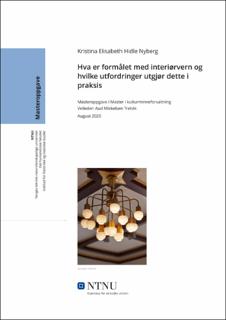| dc.contributor.advisor | Aud Mikkelsen Tretvik | |
| dc.contributor.author | Kristina Elisabeth Hidle Nyberg | |
| dc.date.accessioned | 2021-09-13T16:05:35Z | |
| dc.date.available | 2021-09-13T16:05:35Z | |
| dc.date.issued | 2020 | |
| dc.identifier | no.ntnu:inspera:59159411:21158924 | |
| dc.identifier.uri | https://hdl.handle.net/11250/2775625 | |
| dc.description.abstract | Sammendrag
Identifikasjon og vern av interiør har lenge vært et noe forsømt emne i norsk forvaltning. Interiør har blitt ombygd og fjernet i et høyt tempo rundt om i landet. Nye virksomheter blir etablert, nye eiere flytter inn, og interiøret blir byttet ut i takt med nye trender, smak og behov. Det finnes mye eldre, men også nyere interiør som er verneverdig. Alt fra rosemalerier og utskjæringer, til arkitekttegnede interiører og fresker. Men også husenes konstruksjon og planløsning.
Frem til 2008 var det kun mulig å bevare fast interiør i bygninger gjennom kulturminneloven og fredning. En endring i Plan- og bygningsloven i 2008 åpnet derimot opp for vern av interiør på lik linje med eksteriør. Da interiørvern er at relativt nytt begrep i norsk kulturminnevern valgte jeg i denne oppgaven å utforske følgende problemstilling: «Hva er formålet med interiørvern, og hvilke utfordringer utgjør dette i praksis».
Flere av byantikvarene i Norge, samt flere huseiere bidrog til oppgaven. Hovedfokuset ble hensikten med å verne interiør, interiørets verdi som kulturminne, og hvorfor det derfor bør vernes for fremtiden. Blant annet ble det undersøkt hvor mange av kommunene som har brukt paragrafen i Plan- og bygningsloven til å verne interiør, hva de har vernet og hvorfor. Erfaringer og utfordringer for forvaltningen tas opp. Videre blir også konsekvenser vern av interiør kan ha for eiere og brukere av husene et viktig element å få frem, sammen med huseiernes egne erfaringer. Ut ifra dette ble det mulig å diskutere praksisen rundt vern av interiør.
Interiørvern er enda lite brukt, men det er enkelte kommuner som har vernet interiør i større eller mindre grad. Det er til nå ingen som har vernet interiør i private hjem. I offentlige og halvoffentlige bygg, med interiør som i ulik grad er offentlig tilgjengelig, er interiør blitt vernet. Erfaringene både til byantikvarene, men også eierne har vært overveiende positivt, selv om det også er flere utfordringer. Det ligger derfor mange muligheter i denne typen vern som bør jobbes videre med rundt om i landet. Det som går mye igjen for å få til et vellykket vern er gode løsninger og dialog. | |
| dc.description.abstract | Abstract
Identification and protection of older and newer interiors have been somewhat neglected, and
Interiors are currently being removed and rebuilt at a high pace. New businesses are established, new owners move in, and the interior is therefore replaced in line with new trends, tastes and needs. There are old, but also new and modern interiors that are worthy of being protected. Everything from rosemaling (a Norwegian traditional decorative art) and carvings, to architect-designed interiors and frescoes. Not to mention the layout and construction of the houses. This paper will present several possibilities regarding how one would go forth to preserve house interiors, as well as what to consider when working with this type of protection. Both from a management point of view, but also from the owners’ point of view.
Up until 2008, the only way to protect and preserve interiors in buildings was through the cultural heritage act and conservation. An amendment to the planning and building act made it possible to protect the interior in a similar way as the exterior of the buildings. Interior protection through the planning and building act is a relatively new concept in Norwegian cultural heritage protection. I select in this thesis to explore the following issue: “What is the purpose of interior protection, and what are the challenges this poses in practice”. The main focus here, is the purpose of protecting the interior, and the value that the interior has as a cultural monument. Several of the planning authorities from different Norwegian municipalities have given input to the paper regarding if they used the opportunity to protect the interior. What they have protected, and why they chose to protect exactly that interior are presented, together with challenges and what they foresee with this type of protection. It also became important to look at what consequences interior protection can have for owners and for the use of the houses. Based on this, it then became possible to discuss the practice around protection of interiors.
Interior protection is still in little use, but there are some municipalities that have protected some interior to a certain degree. There are still no one who have protected the interior in private homes. In both public and semi-public buildings however, there are interiors that are available for the public in a varying degree of access. The experiences both for the city antiques, but also the owners have been predominantly positive. Although there are several challenges. There are therefore many opportunities with this type of protection that should be worked with continuously throughout the country. What have been repeated many times is that to achieve a successful protection, one needs good solutions and dialogues. | |
| dc.language | | |
| dc.publisher | NTNU | |
| dc.title | Hva er formålet med interiørvern og hvilke utfordringer utgjør dette i praksis | |
| dc.type | Master thesis | |
